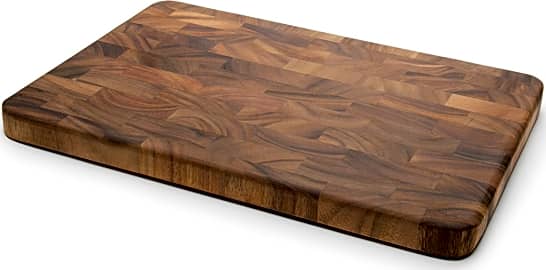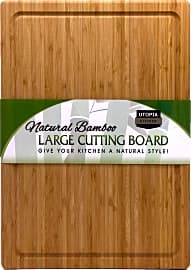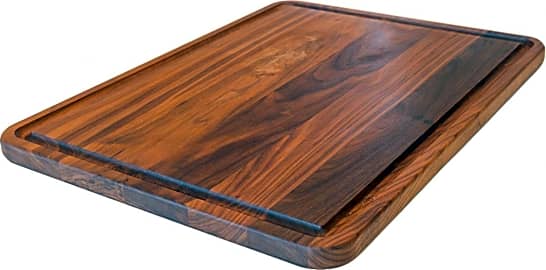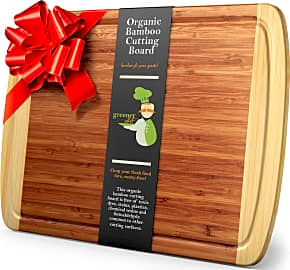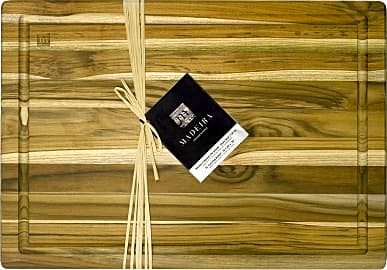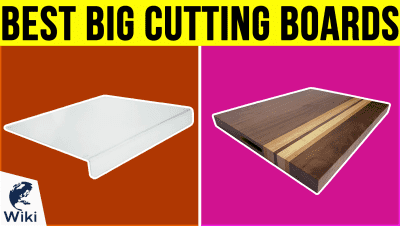The 9 Best Wood Cutting Boards

This wiki has been updated 39 times since it was first published in April of 2015. Wood cutting boards are significantly more gentle on knives than glass or marble, and don't contain the potentially harmful chemicals of plastic. They're even marginally more hygienic than other surfaces as they're able to force bacteria out and dry it up. The right one can keep your kitchen clean while you cook, and offer plenty of room to chop, slice, and dice all kinds of meats and vegetables. When users buy our independently chosen editorial choices, we may earn commissions to help fund the Wiki.
Editor's Notes
August 06, 2021:
There was nothing majorly wrong with any of our selections, but we did want to make this round of updates with an eye on premium quality. As such, we've elevated the Ironwood Gourmet Acacia 28217 to the number 3 spot due to its rustic and classy appearance as well as premium end-grain performance. In fact, that end-grain status is what shaped our two new additions. The Befano Thick is an ultra-stylish option made from soft acacia and rubberwood, while the Walnut Grove End Grain is one of the biggest and nicest looking options on the market and doesn't even cost all that much.
March 06, 2020:
One thing that became immediately apparent during our research into wood cutting boards, is that few products are completely free of complaints about warping or cracks. This really shouldn't come as a surprise to anyone familiar with the properties of wood in general, but when trying to determine the best options, we felt the best way to proceed was to consider the ratio of positive to negative experiences. If we came across products where 98 percent of the people were totally happy with the cutting board, but a few had complaints of it cracking, warping, or coming unglued, we were willing to chalk that up to improper care rather than it being a problem with the board itself. With that in mind, we feel the need to point out that most, if not all, wood cutting boards require periodic oiling to stay in good shape. They also should never be left sitting in water for an extended period of time or run through a dishwasher.
Unlike plastic cutting boards, the wooden variety will often double as countertop decorations or serving platters, so we wanted to include some options with striking grain patterns, such as the Virginia Boys Walnut, Teakhaus Edge Grain 108, Ironwood Gourmet Acacia 28217, Architec Gripperwood GWAT16N, and Madeira 1023.
We also realize that there is often a need to hack through some dense vegetables or large cuts of meat with a heavy cleaver in most kitchens, so we made sure to include some thick, heavy-duty options that can function as a butcher block, such as the sturdy John Boos Ultimate Maple CB1053 and Catskill Craftsmen 1323.
While there is no doubt that wood cutting boards can get very expensive, the Utopia Kitchen UK0058, Greener Chef Extra Large, and Architec Gripperwood GWAT16N prove that you can still get a quality piece without breaking the bank.
Special Honors
Rico & Plato Rubbish Board If you are looking for a way to get through your food prep quicker, the Rico & Plato Rubbish Board can help. It features a large hole in one corner that you can simply sweep all the trimmed bits and pieces into, where they will fall into a drawer and wait until you are ready to empty it. Its crafted from teak and boasts an end-grain construction. ricoplato.com
Jan Barboglio Las Golondrinas Charola Though pricey, the Jan Barboglio Las Golondrinas Charola will make a beautiful center piece on any countertop or island. It has a rough-hewn construction, so the cutting surface isn't flat and smooth like many other options, which just adds to its character, and it features cast-iron bird-shaped handles. janbarboglio.com
A Brief History Of Cutting Boards
Their utility was soon realized for much more than just cutting meat, however.
The first wooden cutting board was likely just a tree stump that a caveman used for support while hacking away at meat with a primitive stone tool. Those tools would soon improve, turning into knives with sharp blades, and the wooden surface would be refined right along with them.
Their utility was soon realized for much more than just cutting meat, however. Many blacksmiths used them while hammering out swords and armor, and as you might expect, these early boards were more like tables, with massive, reinforced legs that were capable of standing up to quite a pounding.
It was butchers that would get the most use out of them, though. They didn't need something that could endure being battered with a hammer, so their blocks were just large cuts of wood rather than full-on tables. These units soon made their way into private homes, as well, as there was a need for a way to prepare meat without dulling utensils.
These blocks worked so well, in fact, that their basic underlying principle was borrowed for a far more macabre purpose: as executioner's blocks. Back when the favored means of doling out justice was an ax to the back of the neck, large wooden slabs were placed under the condemned's head to provide resistance and to protect the blade (after all, you have to have priorities).
By the time that European settlers began moving to the New World, cutting boards had become so ingrained in their culture that they quickly began popping up in America. The virgin country had plenty of timber to use to make boards, and with all the wild game available to hunters, the blocks soon became ubiquitous.
Since cutting boards aren't exactly the most high-tech items, there hasn't been much change in their appearance over the centuries. However, in recent years, the materials used to make these tools have broadened to include plastic, bamboo, and rubber, and the sizes have become smaller as grocery stores have reduced the need to purchase large quantities of meat from a local butcher.
While you may not feel the need to chop up entire animals in your kitchen, having a quality cutting board is still a huge help during meal prep — and, most importantly, you can pretend to be an old-time executioner while you're chopping celery.
How To Use A Cutting Board
The very suggestion that you may not know how to use a cutting board might sound condescending — after all, it's not exactly rocket surgery. Just put it under your food and hack away, right?
Well...it turns out it's not quite so simple. While that strategy will definitely work, in order to get the full value from your board, there are a couple of things you should know about ahead of time.
You don't want your knife slipping while you're in the middle of a chop, and neither do you want to cross-contaminate foods, especially if you've been cutting up raw chicken.
The first thing you should do is place a mat or towel underneath your board before you begin so that it doesn't slide around the counter top. Food prep is difficult — and dangerous — enough as it is without trying to hit a moving target.
Make sure that you're using a board big enough to do the job, as well. While you may feel like it's better to prevent your work space from getting too crowded, using a too-small chef's block only limits your mobility, causing you to contort your hands and increasing the risk that you'll develop carpal-tunnel syndrome someday.
Try to keep the surface of the board as clean and dry as possible, even if you need to wash and dry it off in between foods. You don't want your knife slipping while you're in the middle of a chop, and neither do you want to cross-contaminate foods, especially if you've been cutting up raw chicken.
Once you get the hang of using your new cutting board, you'll find that food prep is much quicker than it used to be — and that your knives stay sharper, too.
Proper Care Of A Wooden Cutting Board
First off, don't ever put your wood cutting board into the dishwasher. You'll need to hand wash it with soap, and dry it thoroughly with a microfiber cloth. Be sure to wash both sides, even if you only used one, as uneven exposure to water can cause one side to warp over time.
First off, don't ever put your wood cutting board into the dishwasher.
Once it's nice and dry, it's time to rub some mineral oil into it. Pour a generous amount over the board, then work it into every nook and cranny. Again, even if you didn't use one side, be sure to oil it anyway so that everything is uniformly moisturized.
After you're done, stand it up on its edge so that both cutting surfaces are exposed to the air, and leave it out to let the oil soak in. Be sure to leave it like this for at least three hours, but overnight is better, if possible.
If you're serious about keeping your board in mint condition, you should then apply a layer of cutting board cream, which is usually a mixture of more mineral oil and beeswax. Apply it with a cloth, and rub it in small, circular motions. Once applied, it should lock the moisture you just applied into the wood, while preventing any further wetness to penetrate, extending the life of the board (and giving it a gorgeous sheen).
While this may sound like a lot of work, you shouldn't need to do it all every night. Once every few weeks should be more than enough for the moisturizing and conditioning, so all you need to do is wash and thoroughly dry it after every use.
Still, despite your best efforts, there may come a time when you have to give up on your trusted kitchen companion. This shouldn't be for many years to come, though, but when it's outlived its usefulness, do the right thing and give it a Viking funeral.



